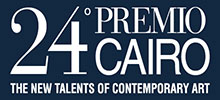10th Premio Cairo
Premio Cairo reaches its tenth anniversary this year.
According to the new formula, launched for the first time during the last edition, a committee of selectors, made up of ten protagonists of the contemporary art world chosen from among museum directors, critics, journalists and curators, has indicated the twenty participating artists, all strictly under 40. The exhibition will be held at the Palazzo della Permanente in Milan from 23 October to 1 November.
Each artist will present two works, one repertory and one specially created for the Award.
Selected artists
Selected artists:
Alterazioni video, Mattia Barbieri. Marco Bongiorni, Rossana Buremi, Valerio Carrubba A. Cataldo - M. Nuzzi, Paolo Cirio, Raffaella Crispino, Tamara Ferioli, M. Fragnito De Giorgio, Alice Guareschi, Sara Magni, Marzia Migliora, Annalisa Pirovano, Gianni Politi, Luca Pozzi, Pietro Ruffo, Francesco Simeti, Federico Spadoni, Lamberto Teotino.
The Jury
The Jury is composed by:
Luca Massimo Barbero – direttore Macro di Roma, Andrea Bruciati – direttore Galleria arte moderna di Monfalcone, Mimmo Di Marzio – giornalista de “il Giornale”, Giacinto Di Pietrantonio – direttore Gamec di Bergamo, Manuela Gandini – giornalista de “La Stampa”, Gianluca Marziani – critico indipendente e giornalista, Franziska Nori – direttore CCCS - Centro la Strozzina di Firenze, Cristiana Perrella – curatrice indipendente, Angela Vettese – curatrice e giornalista de “il Sole 24 ore”, Emma Zanella – direttore Galleria arte moderna e contemporanea di Gallarate
The winner
Premio Cairo 2009, Pietro Ruffo was named the winner with the work Isaiah Berlin.
The monthly magazine Arte dedicated an extensive article and the cover of its January 2010 issue to the artist.
Pietro Ruffo in front of the opera Isaiah Berlin
Graphite and cutouts on paper, 205 x 165 cm
Award-winning work
Pietro Ruffo chooses for his works the long time of painstaking, patient execution that decants the seething matter of current political events, which cools the huge themes of injustice and war, allowing him to address them in a primarily mental and speculative rather than ideological dimension. His is a work born "out of artillery attacks, air raids and diplomatic negotiations," as Boetti said of his tracings of the contours of countries at war. Like Boetti, Ruffo chooses to read and interrogate reality by putting his subjectivity in parentheses, preferring, rather than taking overly defined positions that he knows can be authoritarian and partial, to stimulate individual capacities for thought and expression. Thus even his seemingly more direct and provocative works actually aim not to provide a personal point of view but to open a dialogue. To offer doubts, insights, to rekindle the critical spirit.
